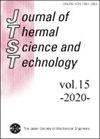Experimental study on the effect of turbulence on hot-smoke dispersion ejecting in a cross flow
IF 0.9
4区 工程技术
Q3 THERMODYNAMICS
引用次数: 0
Abstract
This study aims to investigate the hot-smoke dispersion behavior released from a chimney in a cross flow experimentally using specially designed wind tunnel. An artificially obtained quasi-isotropic turbulence was generated using an active turbulence generator developed by Makita. A heated jet and an unheated jet with smoke are injected into the cross flow from the vertically-oriented chimney installed in the test section. Smoke motion was captured by high-speed camera to obtain instantaneous patterns of the smoke dispersion. Six-kinds of the featured patterns are clearly identified, such as; (I)(II) bifurcated vortex tubes with and without a strong mutual interaction, (III) connected hairpin-type vortices, (IV)(V) the mixture of the coherent and turbulent vortices, (VI) downwash-type structure. These smoke pattern in the downstream field from the chimney are found to be depended on buoyancy, turbulent motion, and inertia forces. Under the quasi-isotropic turbulence, the smoke dispersion prefers to exhibit a meandering pattern (Mode V) under wide range of adopted flow velocities, which is hardly observed using the grid turbulent test device. Interestingly, as compared to the unheated jet, the meandering smoke structure with heated jet ejection was also observed even at the lower jet velocities and the higher cross flow velocities, suggesting that the buoyancy force shall play an important role on appearance of meandering motion and control the smoke dispersion. Direct smoke exposure case (Mode VI) is preferred to be observed when the quasi-isotropic turbulence is imposed, although the trend of appearance depending on the jet temperature can be predicted even using grid turbulent device. It is concluded that using grid turbulence would not be suitable to predict on the smoke dispersion problem in the actual scale. The time averaged smoke concentrations profiles are analyzed at locations along the cross flow direction and it is revealed that the effective diffusion becomes stronger when the quasi-isotropic turbulence is imposed in the cross wind. Further, it is confirmed that the smoke dispersion behavior can be well-characterized by the existing prediction method based on the point source model.湍流对横流中热烟扩散喷射影响的实验研究
本文采用专门设计的风洞,对烟囱在横流条件下的热烟扩散特性进行了实验研究。利用牧田公司研制的有源湍流发生器产生了人工获得的准各向同性湍流。加热射流和带烟的未加热射流从安装在测试段中的垂直烟囱注入到横流中。通过高速摄像机捕捉烟雾运动,获得烟雾扩散的瞬时模式。明确了六种特征纹样,如;(I)(II)有或没有强相互作用的分叉涡管,(III)连接发夹型涡,(IV)(V)相干涡和湍流涡的混合,(VI)下洗型结构。这些烟型在烟囱的下游区域被发现取决于浮力、湍流运动和惯性力。在准各向同性湍流条件下,在较宽的流速范围内,烟气弥散倾向于呈现曲流型(V型),这是栅格湍流试验装置难以观察到的。有趣的是,与未加热射流相比,即使在较低的射流速度和较高的横流速度下,加热射流喷射也能观察到蜿蜒的烟雾结构,这表明浮力对蜿蜒运动的出现和烟雾分散的控制起着重要作用。当施加准各向同性湍流时,更倾向于观察直接烟雾暴露情况(模式VI),尽管即使使用网格湍流装置也可以预测随射流温度变化的外观趋势。结果表明,在实际尺度下,用网格湍流对烟雾扩散问题进行预测是不合适的。分析了沿横流方向各位置的时间平均烟浓度分布,发现在横流中施加准各向同性湍流时,有效扩散增强。进一步验证了现有的基于点源模型的预测方法可以很好地表征烟气的扩散行为。
本文章由计算机程序翻译,如有差异,请以英文原文为准。
求助全文
约1分钟内获得全文
求助全文
来源期刊
CiteScore
2.30
自引率
8.30%
发文量
0
审稿时长
5 months
期刊介绍:
JTST covers a variety of fields in thermal engineering including heat and mass transfer, thermodynamics, combustion, bio-heat transfer, micro- and macro-scale transport phenomena and practical thermal problems in industrial applications.

 求助内容:
求助内容: 应助结果提醒方式:
应助结果提醒方式:


